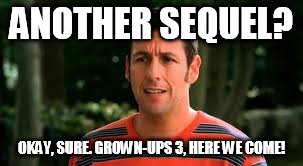They made ANOTHER one of these?
An exploration of Hollywood’s complex relationship with sequels.

January 10, 2017
The clock on the wall reads 10:30 pm. It’s been a long day at school and all you want to do is watch something on TV. You grasp the remote and press the red power button. The 30 inch screen flickers to life. You freeze in absolute terror as Adam Sandler’s mildly demonic face fills the screen while the soundtrack of the award-winning “Grown-Ups 2” blasts from your speakers. “How did another one of these get made?” you exclaim in confusion. This question about why certain films keep getting sequel after sequel is especially relevant today, where currently , 33 of out 50 of the highest grossing films of all time are sequels.
Even with the trend of movies having sequels started way back with ‘The Fall of a Nation”(1916), the past 5 to 10 years have seen a marketed increase in the number of sequels and remakes that Hollywood has produced. In the past 10 years, the number of top grossing films that are also sequels has doubled.
Besides the repetitive nature of the sequelization process, sequels are also much more vulnerable to being of poorly quality and having a disastrous performance at the box office. One recent example of this phenomenon is represented is represented by the iconic “Transformers” franchise, orchestrated by the one, the only, Michael Bay. Each film has been progressively getting worse in quality, as evidenced by the most recent , Age of Extinction(2014), getting a 18 percent on Rotten Tomatoes and a 5.7 from IMBD. Another problem with the overuse of the sequelization process is that sometimes a studio will pump out a sequel or random reboot solely to maintain the rights. A recent example of this phenomena is when Sony Pictures decided to fund a new Spider Man film series in 2011 starring Andrew Garfield to both maintain their rights to Spidey and also attempt to create a film universe along the lines of the Marvel Cinematic Universe. Ultimately, the experiment failed, and after two middling entries, the franchise folded and the rights were given back to Marvel.
Even though many sequels and reboots are of negligent quality and don’t give the original material justice, the sequelization process does not guarantee a forgettable cash grab/ Indeed, in the right hands, a sequel can maintain just as much of a economic and cultural impact as the original. One example of this positive result is how Christopher Nolan took action when Warner Brothers started pushing him to rush the script of The Dark Knight(2008), took his time, and enabled a film universally revered as an incredibly well done piece of cinema to be presented to the public. This trend also applies to reboots as well, as evidenced by how acclaimed show-runner and writer J.J. Abrams revitalized the iconic science fiction series Star Trek into a format for a new generation of fans to enjoy while also paying homage to the original films.
Ultimately, while there are endless challenges and possible disastrous outcomes when making a sequel , the sequelization process is still going on, and some companies are wising up on how to effectively create a sequel. With numerous sequels and reboots coming in 2017 such as Logan, Star Wars Episode VIII, and Kingsman: The Golden Circle, one can only hope that these films have learned from the tribulations of their predecessors and deliver a quality film.
For more info on all the sequels coming out in 2017, check out this fresh new link.
Adam Sandler discusses his thoughts about the complex process of creating a sequel for a franchise.
*Image created via imgflip.com


